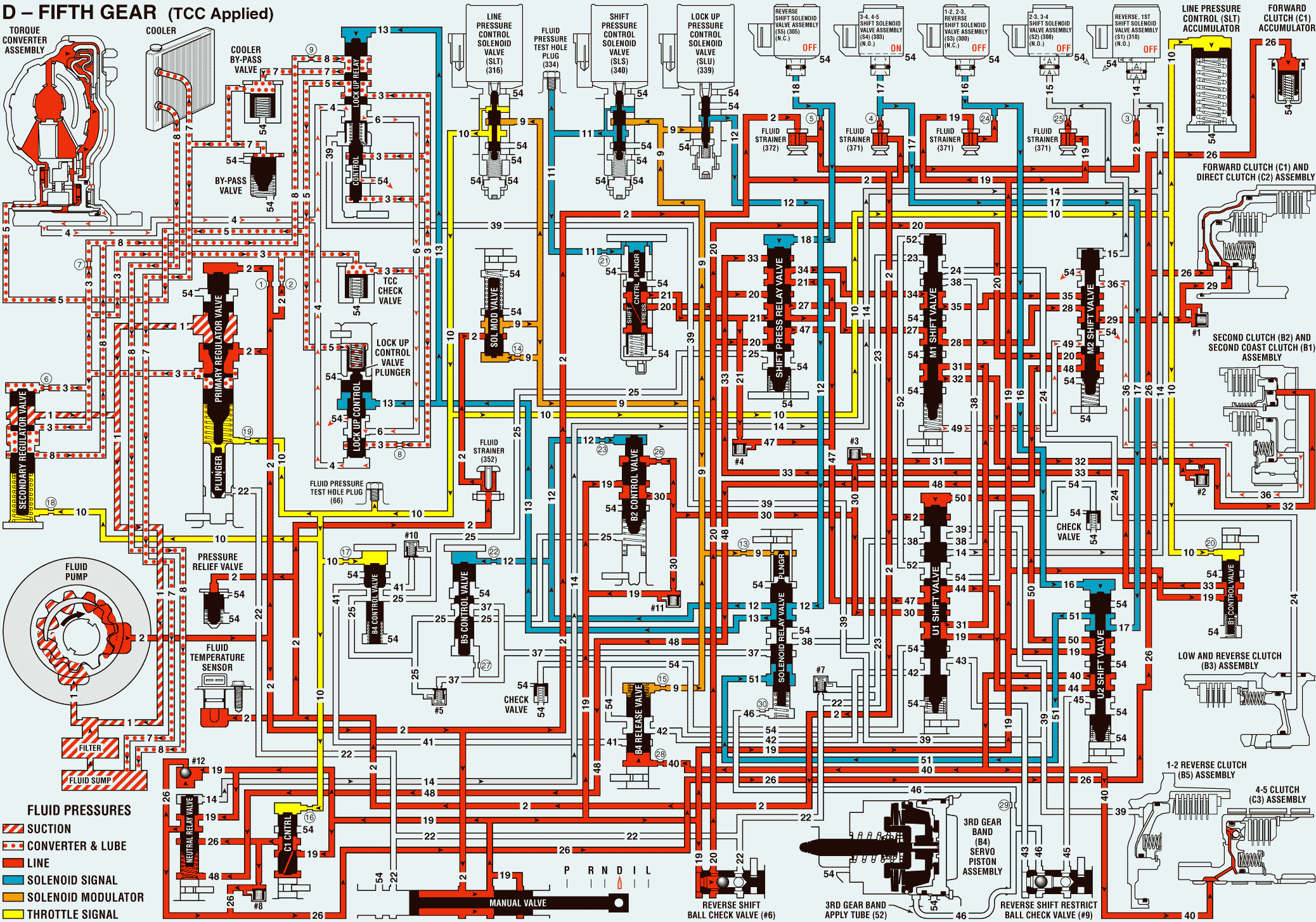When the transmission control module (TCM) determines that the engine and transmission are operating properly to engage the torque converter clutch (TCC), the TCM regulates the duty cycle of the lock up pressure control solenoid valve (SLU).
At this time the Torque Converter Clutch is considered to be disengaged (OFF), lock up pressure control solenoid valve maintains a 90 percent duty cycle.
TCM decision to apply the TCC. The following events occur in order to apply the torque converter clutch.
Stage 1
The TCM immediately decreases the lock up pressure control solenoid valve duty cycle to 0 percent and then pulses the lock up pressure control solenoid valve to approximately 25 percent duty cycle. Solenoid modulator (9) fluid at the lock up pressure control solenoid valve is pulsed into the lock up control (12) fluid circuit. Lock up control (12) fluid is routed to the solenoid relay valve and passes through the valve into the TCC signal (13) fluid circuit. TCC signal (13) fluid is then directed to the lock up relay valve and the lock up control valve. The TCC signal (13) fluid pressure at this point is strong enough to move the lock up relay, and lock up control valves against spring force. The lock up relay valve moves and allows release (4) fluid to begin to exhaust from the torque converter and enter the exhaust enable (6) fluid circuit. The lock up control valve moves and allows release (4)/exhaust enable (6) fluid to exhaust into the sump. This stage is designed to move the lock up relay and lock up control valves from the released position toward the applied position; there is not yet enough pressure to apply the TCC.
Stage 2
The lock up pressure control solenoid valve duty cycle is ramped up to approximately 50 percent. Apply (5) fluid pressure is now strong enough to cause the converter apply to occur. Converter feed (3) pressure enters the apply (5) circuit at the lock up relay valve. The pressure value in the apply (5) circuit should now be high enough to fully apply the TCC pressure plate. Slip speed should be at the correct value (near "0"). In vehicles equipped with the Electronically Controlled Clutch Capacity (ECCC) system, the pressure plate does not fully lock to the torque converter cover. It is instead precisely controlled to maintain a small amount of slippage between the engine and the turbine, reducing driveline torsional disturbances.
Stage 3
If it is determined by the TCM that it is desirable to fully lock the TCC, apply (5) fluid pressure is increased. This is caused by the lock up pressure control solenoid valve duty cycle being increased to approximately 98 percent. This extra pressure ensures that the apply force on the TCC pressure plate is not at the slip threshold, but in the condition of full lock up. TCC plate material is therefore protected from excessive heat.
When the TCC pressure plate is applied, it is held against the torque converter cover. Since it is splined to the converter turbine hub, it provides a mechanical coupling (direct drive) of the engine to the transmission gear sets. This mechanical coupling eliminates the small amount of slippage that occurs in the fluid coupling of a torque converter, resulting in a more efficient transfer of engine torque through the transmission and to the drive wheels.
At this time the Torque Converter Clutch is considered to be engaged (ON).
Important: Under normal operating conditions the torque converter clutch is in the released position while the transmission is operating in the INTERMEDIATE or LOW Ranges. However, when the transmission fluid temperatures exceed approximately 121°C (250°F), the TCM will apply the torque converter clutch in INTERMEDIATE or LOW Range to help reduce fluid temperatures.
PASSAGES
- SUCTION
- LINE
- CONVERTER FEED
- RELEASE
- APPLY
- EXHAUST ENABLE
- COOLER
- LUBE
- SOLENOID MODULATOR
- THROTTLE SIGNAL (SLT)
- SHIFT CONTROL (SLS)
- LOCK UP CONTROL (SLU)
- TCC SIGNAL
- S1 SIGNAL
- S2 SIGNAL
- S3 SIGNAL
- S4 SIGNAL
- S5 SIGNAL
- DRIVE
- DRIVE OR REVERSE
- REGULATED DRIVE OR REVERSE
- REVERSE
- REVERSE CLUTCH
- LOW AND REVERSE CLUTCH
- REVERSE CONTROL
- FORWARD CLUTCH
- DIRECT CLUTCH FEED 1
- DIRECT CLUTCH FEED 2
- DIRECT CLUTCH
- B2 CONTROL 1
- B2 CONTROL 2
- SECOND CLUTCH
- B1 CONTROL 1
- B1 CONTROL 2
- B1 CONTROL 3
- SECOND COAST CLUTCH
- B5 CONTROL 1
- B5 CONTROL 2
- 1-2 REVERSE (B5) CLUTCH
- 4-5 CLUTCH
- B4 CONTROL
- B4 RELEASE
- SERVO RELEASE
- SERVO FEED
- SERVO APPLY
- 3RD GEAR BAND APPLY
- PN12345
- PRN15
- 234NCON
- 345 ENABLE
- 45 ENABLE
- REVERSE INHIBIT
- VENT
- EXHAUST
- SUMP
- VOID
- TORQUE CONVERTER SEAL DRAINBACK
Drive Range Fifth Gear - TCC Applied

